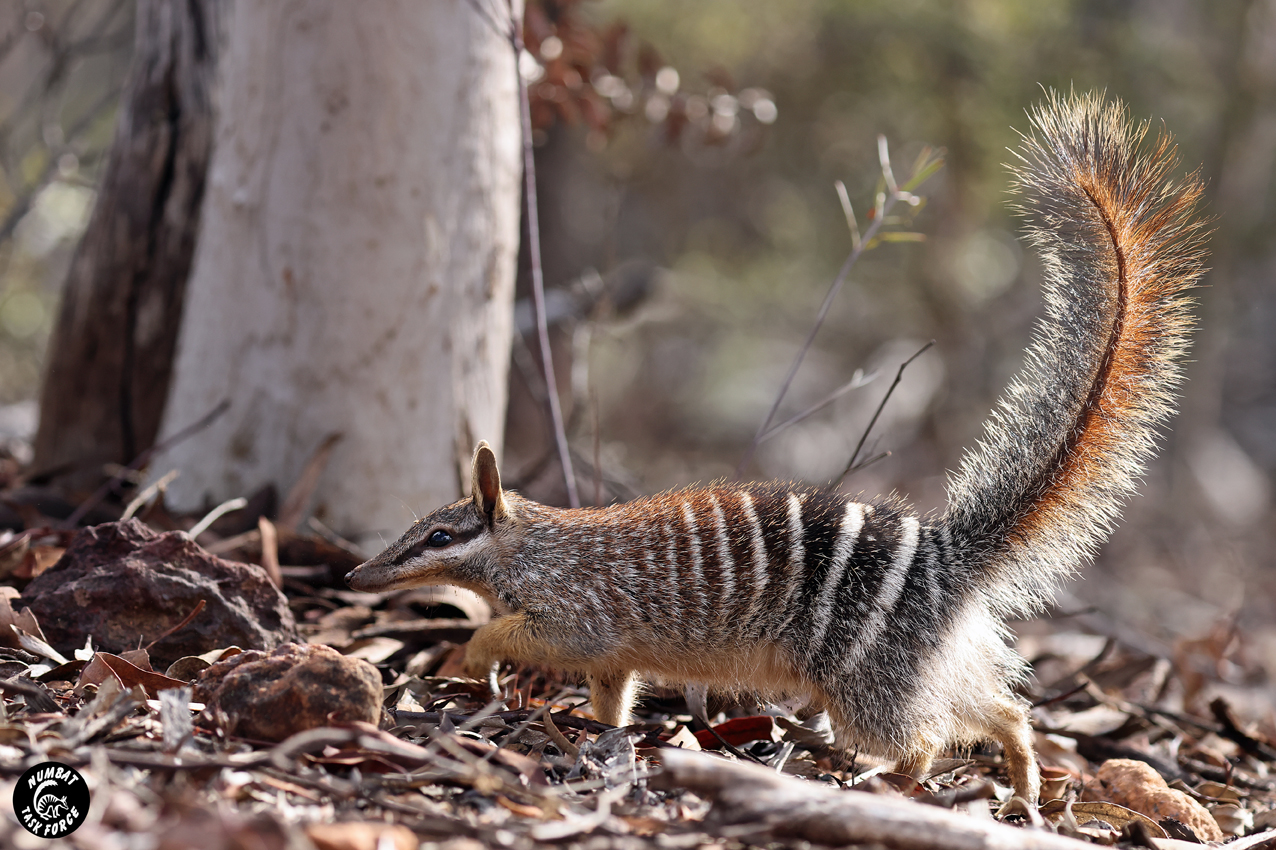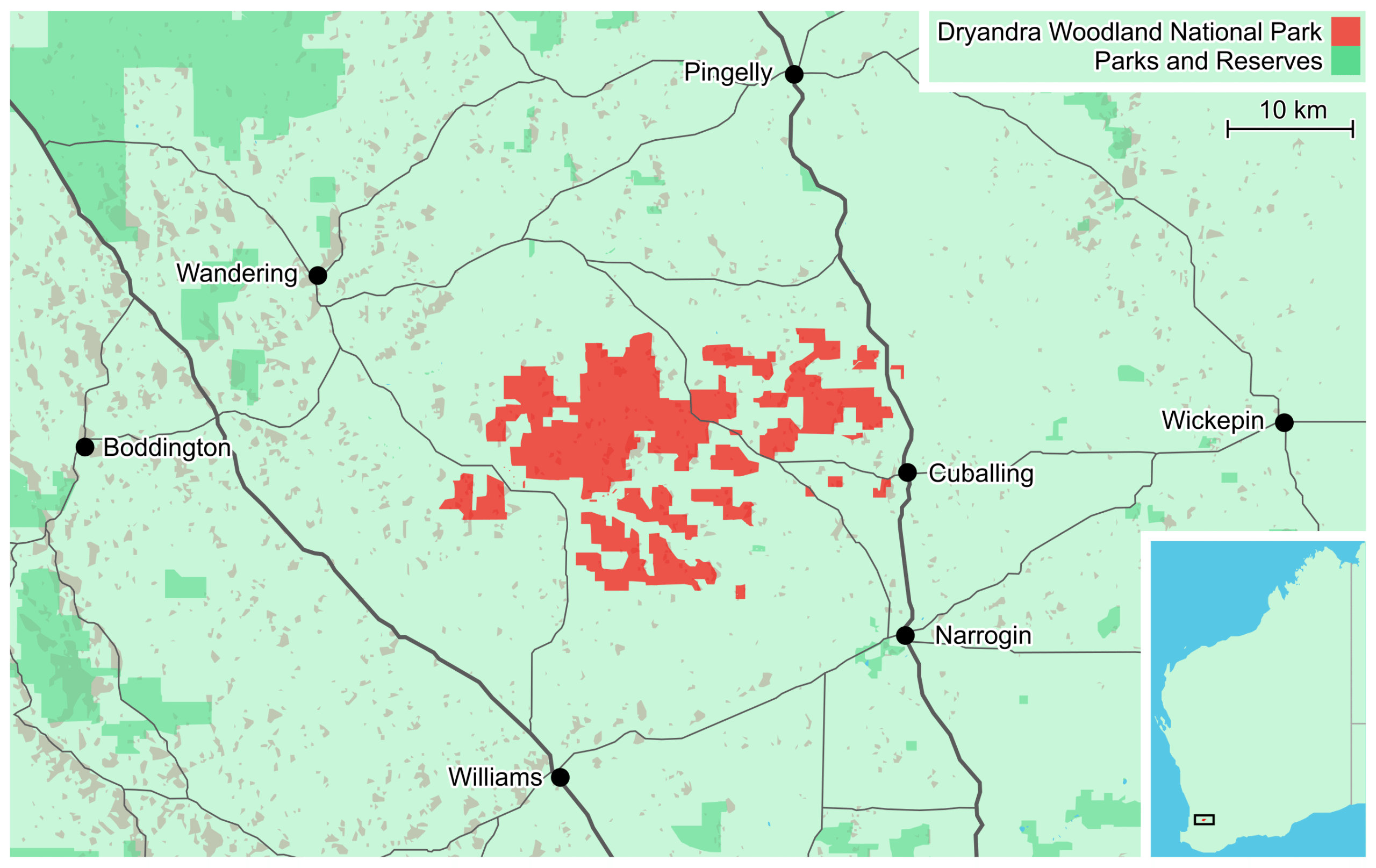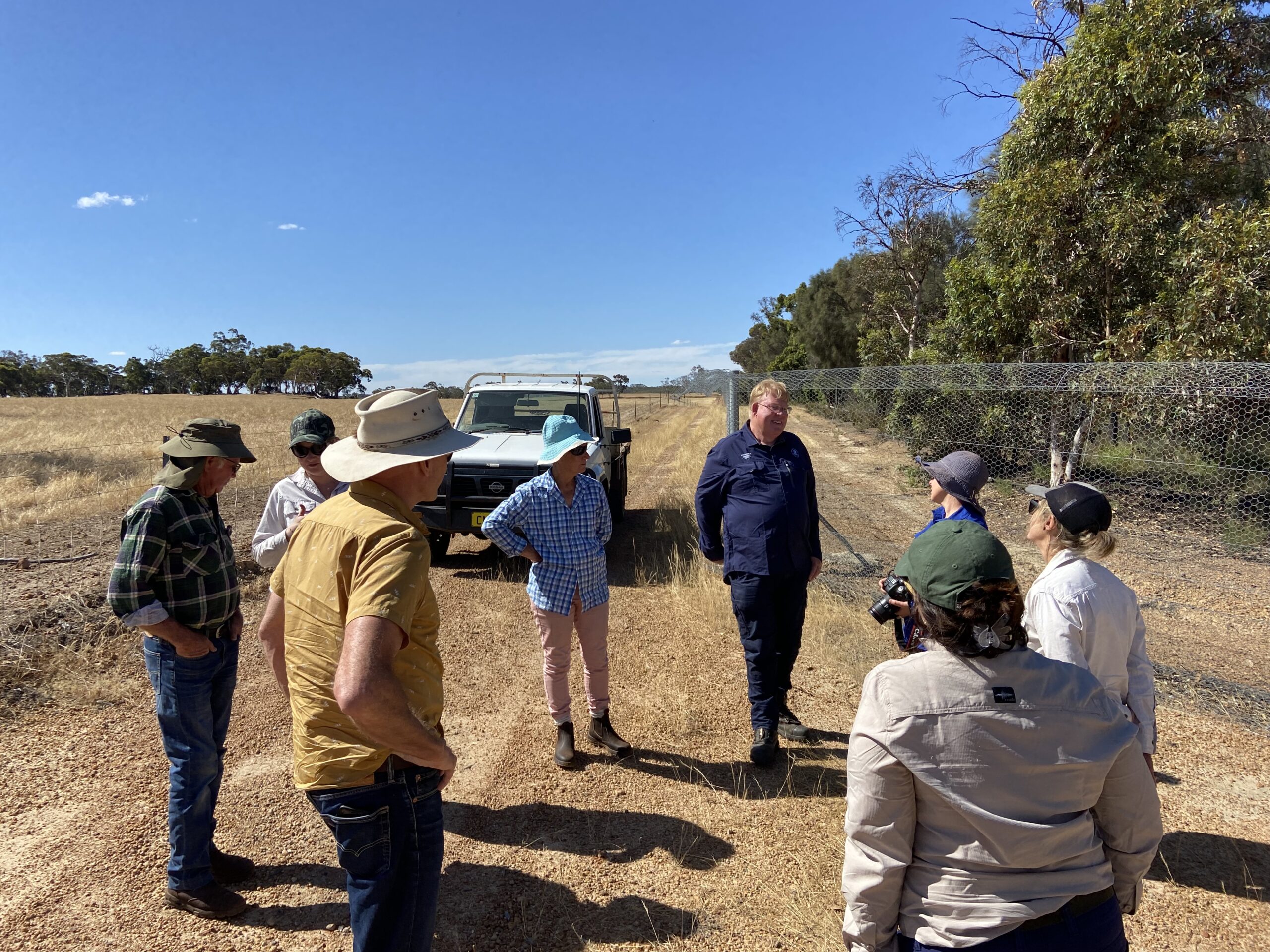Project snapshot:
Protecting some of Australia’s most unique threatened species in Dryandra and surrounds
Showcasing cross tenure landscape-scale collaboration in Western Australia’s wheatbelt:
Dryandra Woodland National Park is an island of bushland nestled in the Western Australian wheatbelt. The traditional owners of this land are the Wilman People of the Noongar Nation. One hundred and sixty kilometres southeast of Perth, it represents one of the largest remaining remnants of native vegetation in the western wheatbelt, spanning more than 28,000 hectares of wandoo, mallet and jarrah woodland across a network of discrete but connected blocks. The country here is gently undulating, rich in native flora and fauna, and steeped in cultural and ecological significance. Once shaped by logging and pastoralism, over the last 50 years the region has shifted towards an ecological focus and is now supporting both farmland and the recovery of at least ten threatened native animals, including the numbat, Western Australia’s faunal emblem.
Declared a national park in 2022, Dryandra’s conservation value lies not only in its size but in its resilience. Despite being fragmented by farmland and far from pristine, its remnant woodlands offer vital refuge for species like the numbat, woylie, red-tailed phascogale, chuditch, tammar wallaby, quenda and malleefowl – many of which have disappeared from elsewhere in the wheatbelt due to habitat loss and predation by introduced species like feral cats and foxes. Dryandra is one of only two areas where wild numbats have persisted and where woylies (brush-tailed bettong) have held on despite being driven to the brink across much of their former range. The survival of these species is closely tied to the management of introduced predators in Dryandra and the surrounds. Here, the region stands as a testament to the effective combination of departmental and community driven management, with the Department of Biodiversity, Conservation and Attractions (DBCA), PHCC, landholders, and community groups like the Numbat Task Force, and Project Numbat all contributing to threatened species conservation.
At the core of the feral cat and fox management efforts in Dryandra is the DBCA’s Western Shield program, one of the largest and longest-running conservation initiatives in Australia. Established in the late 1990s, Western Shield operates across an area roughly half the size of Tasmania and employs an integrated suite of management tools to suppress feral cats and foxes at key fauna recovery sites. In Dryandra, Western Shield operations involve trapping, and baiting with 1080. The targeted use of 1080 poison baits is central to Western Shield’s success. Trapping, shooting and other control measures are undertaking in surrounding farmland, coordinated by PHCC. In Western Australia, the compound is uniquely effective thanks to native plants like Gastrolobium, which naturally contain fluoroacetate (they active toxin in 1080). Many native animals have evolved a degree of tolerance to this compound while introduced predators have not, making 1080 a highly selective and powerful management tool in this region.

Dryandra is one of only two areas where numbats – Western Australia’s faunal emblem – have been able to survive in the wild. Photo: Rob McLean and the Numbat Task Force.
Starting in 1996, sustained baiting in Dryandra has reduced fox numbers by over 80%, allowing native species like the woylie, chuditch and brushtail possum to persist and increase in baited areas compared to unbaited sites. However, in the early 2000’s, DBCA scientists observed that woylie populations were again in decline, reaching a low point in 2014, despite successful fox control. Monitoring of woylies between 2000 and 2014 showed that most died due to predation. The key problem was now feral cats. To counter this, DBCA developed a feral cat targeted bait, Eradicat and expanded its strategy to include more intensive trapping, shooting, and baiting – both inside and outside the park, tackling both feral cats and foxes. Remote camera monitoring revealed that many feral cats were breeding and residing on nearby farmland, only entering the woodland to hunt native species.
This led to the establishment of the Farmers for Fauna project in 2017, a partnership between DBCA, PHCC and Project Numbat. Farmers for Fauna supports local landholders in managing feral cats and foxes on their properties, complementing DBCA’s on-park control. Over 70 farmers attended the launch of the project, which has since grown into a strong collaboration across the Shires of Cuballing, Narrogin, Wandering and Williams. Landholders are provided with cat traps and 1080 baits, training and licensing assistance, and opportunities to engage through knowledge-sharing events and training. The project has empowered farming communities to reduce predation pressure on wildlife and minimise the impacts of introduced predators on agriculture.
Building on this success PHCC have since received funding to deliver a number of other projects based in and around Dryandra Woodland NP including the Numbat Neighbourhood Project (2018-2023 and 2024-2028). This project allowed for the Farmers for Fauna Project to continue and was able to extend the pest animal control by funding a local contractor to conduct feral cat, fox and pig control on farmland surrounding Dryandra. The Dryandra Woonta Project (2022-2023) included a Felixer trial on farmland and in Dryandra, DNA analysis of feral cats and increased pest animal control. The Defending Dryandra project was launched in 2024to further guide off-reserve feral cat control efforts. The project draws on DBCA camera data, results from the Dryandra Woonta Feral Cat DNA analysis study, and the off reserve Felixer trial to focus feral cat control and monitoring on properties surround Dryandra. The project is trialling the use of real-time 4G camera networks to allow for more targeted control of feral cats. Management actions will be recorded into FeralScan to allow effective monitoring of the project and DNA samples taken from feral cats culled for future studies. The aim is to reduce the threat of predation to threatened species in Dryandra Woodland NP, the disease risk to stock on farm and deepening the understanding of feral cat behaviour and identify and mitigate other threats to Dryandra.

Dryandra consists of more than 28,000 hectares of woodland spread across 17 separate blocks of land in WA’s western wheatbelt. Image: CISS, NFCFMC Program.
The results of these combined efforts have been remarkable. -The Numbat Task Force lead by Dr Tony Friend (DBCA’s research scientist) driving survey results increased from only 5 sightings in 2018 to 39 in 2022. DBCA’s camera monitoring data also showed an increase in the numbat population trajectory. By late 2020, the population was estimated at over 400, although it was recognised that a more rigours and reliable survey method would be needed for future surveys. In December 2024, researchers recorded healthy numbat joeys, indicating active breeding. Woylie numbers have also boomed, with 2023 improved survey methods estimating the population at over 5,000 individuals. The Numbat Task Force with Dr Tony Friend also monitor a group of collared numbats which provides critical information on numbat predation helping to guide management requirements in Dryandra to enhance numbat survival and persistence.
Other management programs are being undertaken to protect threatened and other wildlife, alongside introduced predator control. Low intensity prescribed burning specifically have also been successfully implemented in Dryandra. These burns are aimed at regenerating the density and diversity of understory vegetation and enhancing habitat, while also creating low fuel buffers in target areas to protect the woodland from any server wildfire event.
Infrastructure also plays a role in protecting wildlife. In 2016, DBCA constructed a 1,000-hectare predator-proof fenced enclosure within the woodland. This safe haven supports vulnerable populations and acts as a source for future reintroductions. Nearby, the 2.5-hectare Barna Mia sanctuary offers an opportunity to educate the community through nocturnal wildlife tours in a protected setting, helping to raise public awareness and appreciation for Dryandra’s unique biodiversity and how it is being protected.

Feral cat and fox management at Dryandra is collaborative, with various activities undertaken by the Department of Biodiversity, Conservation and Attractions, Peel Harvey Catchment Council, landholders, and community groups. Image: Judy Dunlop.
What makes Dryandra exceptional is not just the success of individual projects, but how they are brought together into a cohesive, landscape-scale approach. DBCA’s Parks and Wildlife Service leads on-ground operations with PHCC, local landholders, scientists, community groups, and Traditional Owners, the Wilman people, providing vital contributions. In a fragmented agricultural landscape, this kind of cooperation is essential for long-term success. Dryandra’s story offers broader lessons for conservation in modified landscapes. Despite a history of disturbance, the park shows that significant recovery is possible when predator management is sustained and partnerships are strong. It demonstrates that species like the numbat and woylie can thrive in mosaics of native bush and farmland, and will even start to venture out into new areas once populations recover, offering hope for other regions facing similar challenges.
With climate change intensifying fire risk, altering predator-prey dynamics and stressing ecosystems, the need for collaborative, adaptive conservation programs has never been greater. The combination of baiting, trapping, monitoring and community engagement at Dryandra is securing a future for some of Australia’s most threatened wildlife and showing what’s possible when people, policy, and science come together.
To get involved, Western Shield invites citizen scientists to participate in Camera Watch, where volunteers help identify species in remote camera images from conservation sites like Dryandra. These insights feed directly into control strategies, helping protect the next generation of Australia’s native fauna.
Information in this section was obtained from the DBCA, PHCC, and Project Numbat [1, 2, 3, 4, 5, 6, 7].
This project snapshot initially appeared in the July 2025 issue of the National Feral Cat and Fox Management Coordination Program Newsletter. To subscribe to the newsletter, click here or fill out the form at the bottom of the page.
Banner photo: PHCC.
Other Resources
Click here to find out more about FeralScan a free community-designed website and smartphone app that allows you to record observations and evidence of introduced pest animals (such as foxes and feral cats), the damage they cause (including predation of native wildlife or lambs), and control actions in your local area (such as baiting, trapping and shooting).
The PestSmart Toolkits provide further information about how to plan, manage and improve your feral cat or fox management program.
The CISS Glovebox Guides, Planning Guides and Field Guides are useful pdf or printed booklets for managing pest animals like feral cats and foxes, developing a simple feral cat or fox management plan or undertaking a best practice baiting program.
